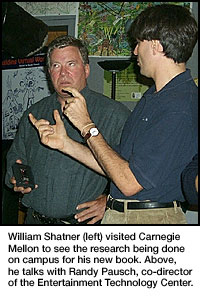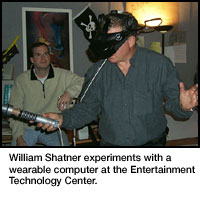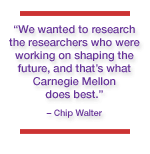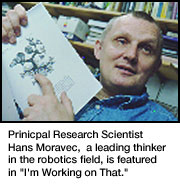|
|
|||||
|
|
Carnegie Mellon Researchers Featured in New Book by William Shatner and Chip Walter
The book highlights some of the work in robotics, virtual reality and wearable and pervasive computing in the School of Computer Science's Entertainment Technology Center(ETC) and Robotics Institute, as well as the Institute for Complex Engineered Systems in the College of Engineering. In addition, "I'm Working on That" explores everything from warp drive and time travel to smart matter and artificial intelligence. The book connects the themes and concepts envisioned by Star Trek more than 30 years ago with research being done to make these technologies realities in the 21st rather than the 23rd century.
The book has been recently featured on NBC-TV's Today Show, in Wired Magazine and in The New York Times.
Shatner and Walter also visited NASA, the Massachusetts Institute of Technology Media Lab, Xerox PARC, the Foresight Institute and Caltech, to name a few.
"Hans always has mind-blowing things to say," said Walter. "Research being done by students and scientists working with HCI Institute Director Dan Siewiorek, Associate Professor Sebastian Thrun and ETC co-Director Randy Pausch was among the most impressive we saw anywhere in the country."
The book is available at the Carnegie Mellon Bookstore for $25.
Excerpted from I'M WORKING ON THAT by William Shatner and Chip Walter, printed with permission of Pocket/Star Trek Books, copyright 2002. Roboburgh is what The Wall Street Journal calls Pittsburgh, Pennsylvania these days. Why? Because the city has shed it's old steel town image and stepped up as one of the nation's leading high tech centers. Among other advanced technologies, it has developed a particularly impressive expertise in robotics. In the past several years half a dozen robotics companies have set up shop in the city's warehouse districts and enterprise zones, and in 1996 it became the home of the National Robotics Engineering Consortium (NREC), a collaboration between Carnegie Mellon University, NASA and several robotics start-ups. Being the home of Carnegie Mellon University hasn't hurt this transformation. Along with Stanford and MIT, Carnegie Mellon is consistently rated as the nation's best in the field of computer science. And one of the reasons Carnegie Mellon has reached such rarified status is because it has a faculty full of wildly creative thinkers like Hans Moravec.
You remember Hans, the other rabble-rousing intellect I mentioned a couple of chapters back who, along with Ray Kurzweil, is focused on, what folks who run in these circles call, the "transhuman condition." Related links:
Entertainment Technology Center
|
|||
|
Carnegie Mellon Home |
|||||
 Carnegie Mellon researchers and some of their cutting edge work take center stage in a new book about the future written by Star Trek's "Captain Kirk," William Shatner, and science writer and future trends specialist Chip Walter. The book, entitled "I'm Working on That: A Trek from Science Fiction to Science Fact" (Simon and Schuster), explores how many of the technologies envisioned in Star Trek's television series and movies are now becoming realties.
Carnegie Mellon researchers and some of their cutting edge work take center stage in a new book about the future written by Star Trek's "Captain Kirk," William Shatner, and science writer and future trends specialist Chip Walter. The book, entitled "I'm Working on That: A Trek from Science Fiction to Science Fact" (Simon and Schuster), explores how many of the technologies envisioned in Star Trek's television series and movies are now becoming realties.
 "When Bill and I began to collaborate on this book, I knew I had to bring him to Pittsburgh," said Pittsburgh native Chip Walter, an adjunct professor in the ETC. "We wanted to research the researchers who were working on shaping the future, and that's what Carnegie Mellon does best. Bill loved it and got a huge kick out of the work we explored here. At one point when we were walking across campus, he looked at me and said, 'These people are amazing.'"
"When Bill and I began to collaborate on this book, I knew I had to bring him to Pittsburgh," said Pittsburgh native Chip Walter, an adjunct professor in the ETC. "We wanted to research the researchers who were working on shaping the future, and that's what Carnegie Mellon does best. Bill loved it and got a huge kick out of the work we explored here. At one point when we were walking across campus, he looked at me and said, 'These people are amazing.'"
 Several chapters in the book explore new technologies being developed at Carnegie Mellon. Principal Research Scientist Hans Moravec, a leading thinker in the field of robotics, is featured along with scientific luminaries like theoretical physicist Kip Thorne, the "father" of nanotechnology Eric Drexler, artificial intelligence expert and inventor Ray Kurzweil and renowned computer scientists Ralph Merkle and Neil Gershenfeld.
Several chapters in the book explore new technologies being developed at Carnegie Mellon. Principal Research Scientist Hans Moravec, a leading thinker in the field of robotics, is featured along with scientific luminaries like theoretical physicist Kip Thorne, the "father" of nanotechnology Eric Drexler, artificial intelligence expert and inventor Ray Kurzweil and renowned computer scientists Ralph Merkle and Neil Gershenfeld.
 The book's title was inspired by a comment made by legendary physicist Stephen Hawking when he was touring the set of "Star Trek The Next Generation". As he was passing by the warp drive engines, he asked what they were. When it was explained, he said, "Oh, I'm working on that."
The book's title was inspired by a comment made by legendary physicist Stephen Hawking when he was touring the set of "Star Trek The Next Generation". As he was passing by the warp drive engines, he asked what they were. When it was explained, he said, "Oh, I'm working on that."